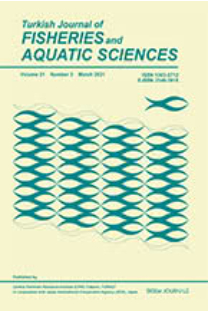Thermal tolerance, oxygen consumption and stress respThermal Tolerance, oxygen consumption and stress response in Danio dangila and Brachydanio rerio (Hamilton, 1822) Acclimated to Four Temperaturesonse in Danio dangila and Brachydanio rerio (Hamilton, 1822) acclimated to four temperatures
___
Beitinger, T.L., Bennett, W.A. and McCauley, R.W. 2000. Temperature tolerances of North American freshwater fishes exposed to dynamic changes in temperature. Environmental Biology of Fishes, 58(3): 237-275.Bevelhimer, M. and Bennett, W. 2000. Assessing cumulative thermal stress in fish during chronic intermittent exposure to high temperatures. Environmental Science and Policy, 3(1): 211–216. doi: 10.1016/S1462-9011(00)00056-3
Carveth, C.J., Widmer, A.M. and Bonar, S.A. 2006. Comparison of upper thermal tolerance of native and nonnative fish species in Arizona. Transactions of the American Fisheries Society 135(6): 1433-1440. doi: 10.1577/T05-025.1
Claussen, D.L. 1977. Thermal acclimation in ambistomatid salamanders. Comparative Biochemistry and Physiology Part A: Physiology, 58(4): 333-340. doi: 10.1016/0300-9629(77)90150-5
Das, T., Pal, A.K., Chakraborty, S.K., Manush, S.M., Chatterjee, N. and Mukherjee, S.C. 2004. Thermal tolerance and oxygen consumption of Indian Major Carps acclimated to four temperatures. Journal of Thermal Biology, 29(3): 157-163. doi: 10.1016/j.jtherbio.2004.02.001
Diaz, F., Re, A.D., Gonzalez, R.A., Sanchez, L.N., Leyva, G. and Valenzuela, F. 2007. Temperature preference and oxygen consumption of the largemouth bass Micropterus salmoides (Lacepede) acclimated to different temperatures. Aquaculture Research, 38(13): 1387–1394. doi: 10.1111/j.1365-2109.2007.01817.x
Dülger, N., Kumlu, M., Türkmen, S., Ölçülü, A., Eroldoĝan, O.T., Yılmaz, H.A. and Öçal, N 2012. Thermal tolerance of European Sea Bass (Dicentrarchus labrax) juveniles acclimated to three temperature levels. Journal of Thermal Biology, 37(1): 79-82. doi: 10.1016/j.jtherbio.2011.11.003
Eme, J. and Bennett,W.A. 2009. Critical thermal tolerance polygons of tropical marine fishes from Sulawesi, Indonesia. Journal of Thermal Biology., 34(5): 220- 225. doi: 10.1016/j.jtherbio.2009.02.005
Fishman, M.C. 2001. Zebrafish-the canonical vertebrate. Science, 294: 1290–1291. doi: 10.1126/science.1066652
Gerhard, G.S. and Cheng, K.C. 2002. "A call to fins! Zebrafish as a gerontological model". Aging Cell, 1(2): 104–111. PMID: 12882339
Herrera, F.D., Uribe, E.S., Ramirez, L.F.B. and Mora, A.G. 1998. Critical thermal maxima and minima of Macrobrachium rosenbergii (Decapoda: Palaemonidae). Journal of Thermal Biology, 23(6): 381–385. doi: 10.1016/S0306-4565(98)00029-1
Hill, A.J., Teraoka, H, Heideman, W. and Peterson, R.E. 2005. "Zebrafish as a Model Vertebrate for Investigating Chemical Toxicity". Toxicological Sciences 86 (1): 6–19. doi: 10.1093/toxsci/kfi110
Ito, L.S., Yamashita, M. and Strüssmann, C.A. 2003. Histological process and dynamics of germ cell degeneration in Pejerrey Odontesthes bonariensis larvae and juveniles during exposure to warm water. Journal of Experimental Zoology Part A: Comparative Experimental Biology, 297A(2): 169-179. doi: 10.1002/jez.a.10249
Iwama, G.K., Vijayan, M.M., Forsyth, R.B. and Ackerman, P.A. 1999. Heat shock proteins and physiological stress in fish. Amer. Zool., 39(6): 901-909. doi: 10.1093/icb/39.6.901
Kita, J., Tsuchida, S. and Setoguma, T. 1996. Temperature preference and tolerance, and oxygen consumption of the marbled rock-fish, Sebastiscus marmoratus. Marine Biology, 125(3): 467-471.
Kothawale, D.R. and Kumar, K.R. 2005. On the recent changes in surface temperature trends over India, Geophysical Research Letters, 32(15): L18714. doi: 10.1029/2005GL023528
Kumar, M. 2011. Evidences, Projections and Potential Impacts of Climate Change on Food Production in Northeast Indian Journal of Hill Farming, 24(1&2): 1- 10.
Kutty, M.N. and Peer Mohamed, M., 1975. Metabolic adaptations of mullet, Rhinomugil cersula (Hamilton) with special reference to energy utilization. Aquaculture 5(3): 253-270. doi: 10.1016/0044- 8486(75)90003-4
MacNutt, M.J., Hinch, S.G., Farrell, A.P. and Topp, S. 2004. The effect of temperature and acclimation period on repeat swimming performance in cutthroat trout. Journal of Fish Biology, 65(2): 342–353. doi: 10.1111/j.0022-1112.2004.00453.x
Magnuson, J.J., Crowder L.B. and Medwick, P.A. 1979. Temperature as an ecological resource. Amer. Zool., 19(1): 331-343. doi: 10.1093/icb/19.1.331
Mahapatra, B.K., Vinod, K. and Mandal, B.K. 2003. Studies on native ornamental fish of Meghalaya with a note on their cultural prospects. Aquaculture 4 (2): 171- 180.
Mahapatra, B.K., Vinod, K. and Mandal, B.K. 2004. Ornamental fish of North Eastern India – Its distribution and conservation status. Environ. Ecol., 22(3): 674-683.
Majhi, S.K., Das, A. and Mandal, B.K. 2006. Growth Performance of Organically Cultured Grass Carp C. idella (Val.) Under Mid-hill Conditions of Meghalaya: North Eastern India. Turkish Journal of Fisheries and Aquatic Sciences, 6: 105-108.
Majhi, S.K., Hattori, R.S., Rahman, S.M., Suzuki, T. and Strüssmann, C.A. 2009. Experimentally-induced depletion of germ cells in sub-adult Patagonian pejerrey (Odontesthes hatcheri). Theriogenology, 71(7) 1162-1172. doi: 10.1016/j.theriogenology.2008.12.008
Re, A.D., Diaz, F., Sierra, E, Rodriguez, J. and Perez, E. 2005. Effect of salinity and temperature on thermal tolerance of brown shrimp Farfantepenaeus aztecus (Ive) (Crustacea, Penaeidae). Journal of Thermal Biology, 30(8): 618-622. doi: 10.1016/j.jtherbio.2005.09.004
Reynolds, W.W. and Casterlin, M.E. 1979. Behavioural thermoregulation and the final preferandum paradigm. Amer. Zool., 19(1): 211-224. doi:10.1093/icb/19.1.193
Strüssmann, C.A., Saito, T. and Takashima, F. 1998. Heat induced germ cell deficiency in the teleosts Odontesthes bonariensis and Patagonina hatcheri. Comparative Biochemistry and Physiology Part A: Molecular & Integrative Physiology, 119 (2): 637- 644. doi: 10.1016/S1095-6433(97)00477-7
Tsuchida, S. 1995. The relationship between upper temperature tolerance and final preferendum of Japanese marine fish. Journal of Thermal Biology, 20(1,2): 35-41. doi: 10.1016/0306-4565(94)00024-D
Vascotto, S.G., Beckham,Y. and Kelly, G.M. 1997. The zebrafish’s swim to fame as an experimental model in biology. Biochemistry and Cell Biology, 75(5): 479– 485. 10.1139/o97-081
- ISSN: 1303-2712
- Yayın Aralığı: 12
- Başlangıç: 2015
- Yayıncı: Su Ürünleri Merkez Araştırma Enstitüsü - Trabzon
The influence of the moon phase on the CPUEs of swordfish gillnet fishery in the aegean sea, Turkey
M. Ashiq Ur RAHMAN, S. Ajmal KHAN, P. S. LYLA, C. Prasanna KUMAR
Ramasamy RAMASUBBURAYAN, Palanisamy IYAPPARAJ, Kanaharaja Joselin SUBHASHINI, Manohar Navin CHANDRAN, Arunachalam PALAVESAM, Grasian IMMANUEL
GONCA ALAK, MUHAMMED ATAMANALP, AHMET TOPAL, HARUN ARSLAN, ERTAN ORUÇ, SERDAR ALTUN
Yanping ZHANG, Sufei JIANG, Yiwei XIONG, ShengMing SUN, Hui QIAO, Shubo JIN, Yongsheng GONG, Hongtuo FU
Hye Rim KİM, Jung Hwa CHOI, Won Gyu PARK
Ensieh Habibi, Mohammad Reza KALBASSİ, Seyed Javad HOSSEINI, Seyed Ahmad QASEMI
Majid NASERIZADEH, Omid SAFARI, Mohammad Ali NEMATOLLAHI
Sung-Sam KIM, Samad RAHIMNEJAD, Kang-Woong KIM, Kyeong-Jun LEE
